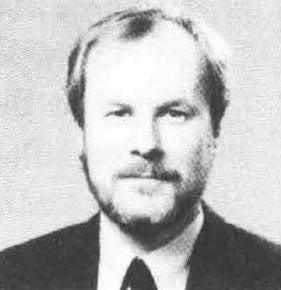Ellis Named Head of Theory Department

Keith Ellis
Director John Peoples has appointed Keith Ellis head of the Theoretical Physics Department. Keith replaces Bill Bardeen who is leaving the Laboratory to head the newly forming Theory Department at the SSC Laboratory. Bill served as head of the Fermilab Theory Department for five years. "Bill has been a superb head of the theory group here and it will certainly be a challenge to do the job as well as he has done," said Keith.
A native of Aberdeen, Scotland, Keith joined the Laboratory in 1984. He has a Ph.D. in physics from the University of Oxford. Prior to joining the Fermilab staff, Keith served on the research staff at Instituto di Fisica in Rome, Italy and as a research fellow at CERN, CAL TECH, MIT and Imperial College, London.
Chris Quigg, a member of the department who served as its head from 1977 until 1987, is excited about Keith's recent appointment. "I am quite delighted that Keith has agreed to do this. He is a first-rate scientist and one of the most important people in the world for the study of the strong interactions--really the acknowledged expert. He is a person with very high standards and a lot of energy. He will have new ideas and a new vision which will really be very good for us."
There are now approximately 25 members of the theory group. But, according to Keith, there has been some turnover which he views as positive. "It is good that people come here and experience the research environment and then move on to positions of influence elsewhere in the community." Traditionally, particle theory in the US has been done at universities. According to Chris, there is a special opportunity here at Fermilab for theorists who are interested in having a frequent interchange with experiments.
The theory program has existed at Fermilab since the beginning of the Laboratory and became a permanent part of the Laboratory in the early 1970s. Ben Lee, a Stony Brook theorist served as the first head of the Fermilab Theory Department. According to Chris, Ben set out to build a strong theoretical physics department-not just one that concentrated on day-to-day, routine types of problems, but one from which ideas would come. "Since Fermilab was to be the most important Lab in the U.S. in particle physics, it was our goal to have a theoretical physics department that was matched to that," said Chris.
From its inception, the Theory Department has served as one of the centers of the intellectual life at the Laboratory. A very early contribution made by the department to the scientific community was the introduction of the wine and cheese seminars in the fall of 1972. This Joint Experimental Theoretical Seminar designed for the informal exchange of ideas has now grown from a small gathering of around 20 people to an "almost national" seminar that often bursts the confines of Curia II.
The Fermilab Theory Department is made up of people who are interested in particle physics and try to make sense of the experiments that are done here and elsewhere. Keith described the department as the "intellectual powerhouse of the Laboratory." "We generate some of the ideas which get tested in the experiments. We work out in detail the ramifications of those ideas. We also have a lively interest in advanced computing which is required for our lattice gauge project."
Aside from the experimental link, the Theory Department also has members who are dealing with the more abstract side of theoretical physics. "We have people who work on the more formal aspects of quantum field theory," said Keith. "It is quite important for the rest of us who value the links with the experimental program to have those people around because it is part of the stimulation for us to understand the formal developments and ideas," said Chris. The Theory Department also has a close relationship with the Astrophysics Department. Several times in the past collaborative papers have been written by members of the two groups.
Over the years, theorists have helped steer the agenda of the high-energy physics program by looking ahead and making suggestions for future measurements or machines. One such example was a now famous paper, written by Estia Eichten, Fermilab, I. Hinchliffe, Lawrence Berkeley Laboratory, K. Lane, Boston University, and Chris Quigg, Fermilab, that formed the scientific case for the SSC. "By no means does this mean that all the important developments have begun at Fermilab, but certainly a fair share of the most influential work has been done here," said Chris.
As the head of a department with a distinguished past, Keith is very excited about the future at Fermilab and the challenges ahead. "We are very excited that the top quark may be discovered here within the next year. We had many people in our group who worked very actively on estimating signals and backgrounds for the top." "The opportunity to be at a place where our ideas or the ideas of our colleagues are actually put into action and tested is very special," said Chris.


